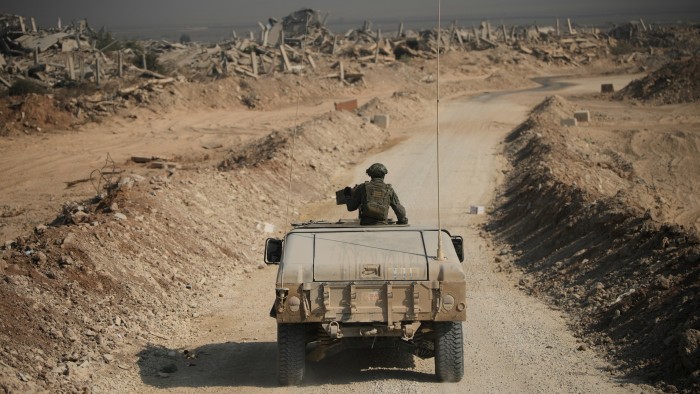Arab countries are pushing against a US-backed proposal to rebuild a “New Gaza” in the Israeli-controlled half of the enclave, which they fear could lead to the long-term partition of the Palestinian territory.
Since the US-brokered ceasefire between Israel and Hamas took force last month, Gaza has been split along the so-called Yellow Line, with Israeli forces occupying one side and Hamas in effect in control of the other, where the vast majority of Palestinians are currently located.
The scale of the devastation in Gaza — much of which has been reduced to rubble by Israel’s two-year offensive against Hamas — has made rebuilding the enclave a priority for western and Arab nations.
Israeli and US officials have ruled out allowing reconstruction funds to flow to Hamas-controlled areas. But several — including President Donald Trump’s son-in-law Jared Kushner — have floated the idea of starting to rebuild the Israeli-controlled side, arguing that it could offer Palestinians a positive alternative to the militant group.
This plan, which has similarities with other since-discarded proposals for Hamas-free “bubbles” put forward by Israeli officials during the war, has alarmed Arab, Muslim and European states, which have relayed their concerns to the US.
“There is a clash coming on this between Palestinians, Egyptians, many others, Qataris, Turks and the US and Israel if the US continues to support the Israeli point of view on this, which would be totally outrageous,” said one Arab diplomat.
US officials have argued that the idea would kick-start reconstruction of the shattered enclave, and allow the creation of a demilitarised “New Gaza” that would not pose a threat to Israel and prove more attractive for Palestinians.
“There are considerations happening now about the areas that the [Israeli military] controls, as long as that can be secured, to start the construction for a ‘New Gaza’, in order to give the Palestinians living in Gaza a place to go, a place to get jobs, a place to live,” Kushner, one of the main architects of Trump’s 20-point ceasefire plan, said last month.
An Israeli official said the idea was one of several options under discussion.
However, several aspects of the two-tier plan — which analysts said would require extensive security arrangements to enforce — have prompted concern among Arab states.
The first is that — although in Trump’s peace plan the Yellow Line is a temporary boundary that will recede as Israel withdraws from the enclave — the division could become permanent.
“We cannot have fragmentation of Gaza. Gaza is one and part of the Palestinian Territories,” Ayman Safadi, Jordan’s foreign minister, told a conference this month, adding that the crucial issue was setting a timeline for Israel’s withdrawal.
“The optics would be disastrous. It would look like we are building for Israel and not the Palestinians,” said a second Arab diplomat. “We don’t want Gaza to become this sort of limbo between war and peace and [where] the current situation becomes the status quo.”
The diplomat said no Arab state would provide funds for construction on that basis, adding that “collectively we have said that”.
Under Trump’s 20-point plan, Israel is supposed to withdraw from Gaza in phases as an international stabilisation force deploys in the strip. But the size, mandate and contributors to the force remain unclear.
A second issue — which has provoked particular concern in Egypt — is the possibility that reconstruction would be piloted in Rafah in southern Gaza, across the border from Egypt. Concentrating Gazans in this area, another diplomat said, would make it easier for Israel to attempt to displace Palestinians into Egypt, if it decided to do so.
Hardline members of Prime Minister Benjamin Netanyahu’s government have repeatedly raised the prospect of displacing Gazans from the enclave, with Trump himself touting a since-abandoned plan to “resettle” Palestinians and create a “Gaza Riviera”.

Even within the Israeli security establishment, there are some who doubt the “New Gaza” plan is realistic.
Hamas would be certain to try and disrupt it, said Michael Milshtein, a former Israeli intelligence officer, adding that it would take years to achieve and that splitting up a territory as small as Gaza would inevitably divide families.
But the bigger problem, he argued, was that — like other plans put forward by Israeli and US officials during the war, ranging from the Hamas-free “bubbles” to corralling Gazans into a “humanitarian city” in the ruins of Rafah — the plan repeated Israel’s failed prewar strategy of using limited economic incentives as one of its tools to try and contain Hamas.
“This is the misconception that led to October 7,” he said. “It’s an illusion.”
Other observers are sceptical that Palestinians displaced multiple times during the war would want to uproot themselves again to, in effect, live under Israeli occupation.
“The notion that you could prove to Gazans that the better life is available when not under Hamas rule, I suppose, is something that we hope is true,” said Dan Shapiro, a former US ambassador to Israel.
“But I think it’s very hard to imagine either the investment or the movement of the population into that area, at least in the near term.”
A person familiar with Gulf Arab thinking echoed those concerns. The main focus, they said, was at present on humanitarian aid, and it was possible that Gulf states might agree to provide funding for this in the Israeli-controlled part of Gaza. “But other things — no.”
Read the full article here



